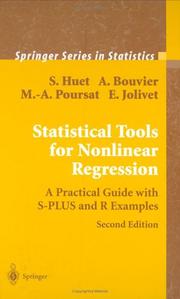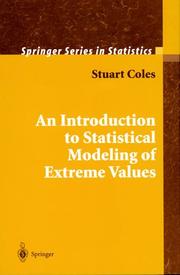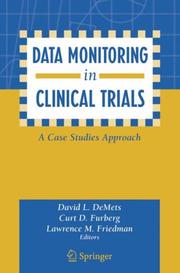| Listing 1 - 10 of 17 | << page >> |
Sort by
|
Book
ISSN: 17685656 ISBN: 9782817801575 9782817801568 2817801563 Year: 2010 Publisher: Paris: Springer,
Abstract | Keywords | Export | Availability | Bookmark
 Loading...
Loading...Choose an application
- Reference Manager
- EndNote
- RefWorks (Direct export to RefWorks)
Cet ouvrage expose les fondements théoriques des méthodes classiques de la statistique (estimation et tests) ainsi que des approches introduites plus récemment. Les premiers chapitres sont consacrés aux notions de la théorie des probabilités, nécessaires à la statistique. Puis sont développés les tests et méthodes d'estimation dans les situations paramétriques et non paramétriques. Les modèles de base de la régression sont traités en fin d'ouvrage. Chaque chapitre est accompagné d'exemples concrets, mais aussi d'exercices - plus de 150 au total - dont les corrigés ont été intégrés dans cette deuxième édition. La présentation témoigne d'un réel souci pédagogique de l'auteur qui bénéficie d'une vaste expérience d'enseignement auprès de publics très variés. Les résultats exposés sont, autant que possible, replacés dans la perspective de leur utilité pratique. Le niveau mathématique requis rend ce livre accessible aux étudiants de premier cycle universitaire et aux chercheurs dans les divers domaines des sciences appliquées. Il sera donc utile aux étudiants devant aborder les aspects théoriques de la statistique ou aux utilisateurs, pour les assurer du choix judicieux des méthodes qu'ils emploient.
Statistics. --- Statistical Theory and Methods. --- Statistics for Life Sciences, Medicine, Health Sciences. --- Statistics for Social Science, Behavorial Science, Education, Public Policy, and Law. --- Mathematical statistics. --- Statistique --- Statistique mathématique --- Statistics as Topic
Book
ISBN: 9781441997821 1441997814 9783030097363 9781441997814 1441997822 3030097366 Year: 2011 Publisher: New York, NY : Springer New York : Imprint: Springer,
Abstract | Keywords | Export | Availability | Bookmark
 Loading...
Loading...Choose an application
- Reference Manager
- EndNote
- RefWorks (Direct export to RefWorks)
The statistics profession is at a unique point in history. The need for valid statistical tools is greater than ever; data sets are massive, often measuring hundreds of thousands of measurements for a single subject. The field is ready to move towards clear objective benchmarks under which tools can be evaluated. Targeted learning allows (1) the full generalization and utilization of cross-validation as an estimator selection tool so that the subjective choices made by humans are now made by the machine, and (2) targeting the fitting of the probability distribution of the data toward the target parameter representing the scientific question of interest. This book is aimed at both statisticians and applied researchers interested in causal inference and general effect estimation for observational and experimental data. Part I is an accessible introduction to super learning and the targeted maximum likelihood estimator, including related concepts necessary to understand and apply these methods. Parts II-IX handle complex data structures and topics applied researchers will immediately recognize from their own research, including time-to-event outcomes, direct and indirect effects, positivity violations, case-control studies, censored data, longitudinal data, and genomic studies. "Targeted Learning, by Mark J. van der Laan and Sherri Rose, fills a much needed gap in statistical and causal inference. It protects us from wasting computational, analytical, and data resources on irrelevant aspects of a problem and teaches us how to focus on what is relevant – answering questions that researchers truly care about." -Judea Pearl, Computer Science Department, University of California, Los Angeles "In summary, this book should be on the shelf of every investigator who conducts observational research and randomized controlled trials. The concepts and methodology are foundational for causal inference and at the same time stay true to what the data at hand can say about the questions that motivate their collection." -Ira B. Tager, Division of Epidemiology, University of California, Berkeley.
Statistical science --- Biomathematics. Biometry. Biostatistics --- Hygiene. Public health. Protection --- volksgezondheid --- medische statistiek --- biostatistiek --- biometrie --- statistisch onderzoek --- Mathematical statistics --- Inference --- Statistics . --- Public health. --- Statistical Theory and Methods. --- Public Health. --- Statistics for Life Sciences, Medicine, Health Sciences. --- Inference. --- Mathematical statistics.

ISBN: 0387954023 9780387954028 0387954031 9786610009558 1280009551 0387224637 Year: 2002 Publisher: New York, NY : Springer New York : Imprint: Springer,
Abstract | Keywords | Export | Availability | Bookmark
 Loading...
Loading...Choose an application
- Reference Manager
- EndNote
- RefWorks (Direct export to RefWorks)
Arguably the most intricate dynamic object in the universe, the human brain is an unsounded source of wonder for the scienti?c community. The primary aim of this book is to provide both students and established - vestigators in the growing area of neuroscience with an appreciation of the roles that mathematics may play in helping to understand this en- maticorgan. Alongwithdiscussionsofresultsobtainedbytheneuroscience community, emphasis is placed on suggesting fruitful research problems for those planning to embark on mathematical studies in neuroscience. To make the overall perspectives understandable to philosophers and psychologists, essential features of the discussions are presented in ordinary English, with more detailed mathematical comments in appendices and footnotes. Although it attempts to maintain both clarity and biological relevance, this is not a text on the anatomy of nerve systems; thus readers should bring some knowledge of neurophysiology through other courses, associated studies, or laboratory research. It is a guiding theme throughout the book that the brain is organized into several quite di?erent levels of dynamic activity. As will be seen, these levels are hierarchically structured, beginning with the molecular dynamics ofintrinsicmembraneproteinsandproceedingupward,throughtheswit- ing properties of active membrane patches and synapses, the emergence of impulses on active ?bers, overall properties of individual neurons, and the growth of functional assemblies of interacting neurons, to the global - namics of a brain. At each level of description, reality turns di?erent facets of her mystery to us, and diverse phenomena make their contributions to the brain’s collective behavior.
Physiology of nerves and sense organs --- Computer. Automation --- Mathematics --- #PBIB:2004.3 --- Neurosciences --- Mathematical models. --- Life sciences. --- Neurosciences. --- Neurobiology. --- Biomathematics. --- Statistics. --- Life Sciences. --- Statistics for Life Sciences, Medicine, Health Sciences. --- Mathematical and Computational Biology. --- Neural sciences --- Neurological sciences --- Neuroscience --- Medical sciences --- Nervous system --- Mathematical models --- Statistics . --- Biology --- Statistical analysis --- Statistical data --- Statistical methods --- Statistical science --- Econometrics
Book
ISBN: 9781441915863 9781441915856 1441915850 Year: 2010 Publisher: New York Springer Science & Business Media
Abstract | Keywords | Export | Availability | Bookmark
 Loading...
Loading...Choose an application
- Reference Manager
- EndNote
- RefWorks (Direct export to RefWorks)
This is the fourth edition of a very successful textbook on clinical trials methodology, written by three recognized experts who have long and extensive experience in all areas of clinical trials. Most chapters have been revised considerably from the third edition. A chapter on ethics has been added and topics such as noninferiority and adaptive designs now receive considerable discussion. There is much new material on adverse events, adherence, data monitoring, and issues in analysis. This book is intended for the clinical researcher who is interested in designing a clinical trial and developing a protocol. It is also of value to researchers and practitioners who must critically evaluate the literature of published clinical trials and assess the merits of each trial and the implications for the care and treatment of patients. The authors use numerous examples of published clinical trials from a variety of medical disciplines to illustrate the fundamentals. The text is organized sequentially from defining the question to trial closeout. One chapter is devoted to each of the critical areas to aid the clinical trial researcher. These areas include pre-specifying the scientific questions to be tested and appropriate outcome measures, determining the organizational structure, estimating an adequate sample size, specifying the randomization procedure, implementing the intervention and visit schedules for participant evaluation, establishing an interim data and safety monitoring plan, detailing the final analysis plan, and reporting the trial results according to the pre-specified objectives. Although a basic introductory statistics course is helpful in maximizing the benefit of this book, a researcher or practitioner with limited statistical background would still find most if not all the chapters understandable and helpful. While the technical material has been kept to a minimum, the statistician may still find the principles and fundamentals presented in this text useful. This book has been successfully used for teaching courses in clinical trial methodology.
Statistics. --- Statistics for Life Sciences, Medicine, Health Sciences. --- Public Health/Gesundheitswesen. --- Epidemiology. --- Cancer Research. --- Oncology. --- Statistique --- Cancérologie --- Epidémiologie --- Clinical Trials --- Clinical trials --- Controlled clinical trials --- Patient trials of new treatments --- Randomized clinical trials --- Trials, Clinical --- Clinical medicine --- Human experimentation in medicine --- Research

ISBN: 1280460989 9786610460984 1402041276 1402041268 9781402041266 9781402041273 9048170508 Year: 2006 Publisher: Dordrecht : Springer Netherlands : Imprint: Springer,
Abstract | Keywords | Export | Availability | Bookmark
 Loading...
Loading...Choose an application
- Reference Manager
- EndNote
- RefWorks (Direct export to RefWorks)
Hierarchy is a form of organisation of complex systems that rely on or produce a strong differentiation in capacity (power and size) between the parts of the system. It is frequently observed within the natural living world as well as in social institutions. According to the authors, hierarchy results from random processes, follows an intentional design, or is the result of the organisation which ensures an optimal circulation of energy for information. This book reviews ancient and modern representations and explanations of hierarchies, and compares their relevance in a variety of fields, such as language, societies, cities, and living species. It throws light on concepts and models such as scaling laws, fractals and self-organisation that are fundamental in the dynamics and morphology of complex systems. At a time when networks are celebrated for their efficiency, flexibility and better social acceptance, much can be learned about the persistent universality and adaptability of hierarchies, and from the analogies and differences between biological and social organisation and processes. This book addresses a wide audience of biologists and social scientists, as well as managers and executives in a variety of institutions.
Hierarchies. --- Order --- Geografie --- Sociale en economische geografie --- Algemeen. --- Social stratification --- Organization. --- Social sciences --- Systems theory. --- Social sciences. --- Genetic epistemology. --- Statistics. --- Methodology of the Social Sciences. --- Systems Theory, Control. --- Social Sciences, general. --- Epistemology. --- Statistics for Life Sciences, Medicine, Health Sciences. --- Methodology. --- System theory. --- Statistical analysis --- Statistical data --- Statistical methods --- Statistical science --- Mathematics --- Econometrics --- Developmental psychology --- Knowledge, Theory of --- Behavioral sciences --- Human sciences --- Sciences, Social --- Social science --- Social studies --- Civilization --- Organisation --- Management --- Systems, Theory of --- Systems science --- Science --- Philosophy --- Planning. --- Statistics . --- Epistemology --- Theory of knowledge --- Psychology --- Creation (Literary, artistic, etc.) --- Executive ability --- Organization --- Social sciences (general) --- Biomathematics. Biometry. Biostatistics --- Environmental planning --- Linguistics --- medische statistiek --- ruimtelijke ordening --- biostatistiek --- sociale wetenschappen --- epistomologie --- linguïstiek --- biometrie --- kennisleer

ISBN: 9781402041822 1402041829 9781402045868 904817063X 9786610724680 1280724684 1402045867 Year: 2006 Publisher: Dordrecht : Springer Netherlands : Imprint: Springer,
Abstract | Keywords | Export | Availability | Bookmark
 Loading...
Loading...Choose an application
- Reference Manager
- EndNote
- RefWorks (Direct export to RefWorks)
At present, quantitative ecological risk assessment is widely used in different contexts, however very often without an understanding of the natural mechanisms that drive the processes of environmental and human risk. Its application is often accompanied by high uncertainty about risk values. On the other hand, the sustainability of modern technoecosystems is known because of their natural biogeochemical cycling that has been transformed to various extents by anthropogenic studies. Accordingly our understanding of the principal mechanisms that drive the biogeochemical food webs allows us to present a quantitative ecological risk assessment and to propose technological solutions for management of various ERA enterprises. It also enables us to devise a powerful mechanism for ecological insurance, to assign responsibilities and protect rights while managing the control of damage from natural and anthropogenic accidents and catastrophes.
Biogeochemistry. --- Biogeochemical cycles. --- Biogéochimie --- Cycles biogéochimiques --- Ecology. --- Environmental sciences. --- Geological modeling. --- Statistics. --- Biogeochemistry --- Biogeochemical cycles --- Earth & Environmental Sciences --- Biology --- Health & Biological Sciences --- Ecology --- Biology - General --- Life sciences. --- Ecotoxicology. --- Life Sciences. --- Statistics for Life Sciences, Medicine, Health Sciences. --- Environmental Monitoring/Analysis. --- Cycles --- Biochemistry --- Geochemistry --- Environmental toxicology. --- Monitoring/Environmental Analysis. --- Ecotoxicology --- Pollutants --- Pollution --- Environmental health --- Toxicology --- Statistical analysis --- Statistical data --- Statistical methods --- Statistical science --- Mathematics --- Econometrics --- Balance of nature --- Bionomics --- Ecological processes --- Ecological science --- Ecological sciences --- Environment --- Environmental biology --- Oecology --- Environmental sciences --- Population biology --- Ecology . --- Statistics . --- Environmental monitoring. --- Biomonitoring (Ecology) --- Ecological monitoring --- Environmental quality --- Monitoring, Environmental --- Applied ecology --- Environmental engineering --- Measurement --- Monitoring

ISBN: 0387400818 9786610189113 1280189118 0387215743 Year: 2004 Publisher: New York, NY : Springer New York : Imprint: Springer,
Abstract | Keywords | Export | Availability | Bookmark
 Loading...
Loading...Choose an application
- Reference Manager
- EndNote
- RefWorks (Direct export to RefWorks)
Statistical Tools for Nonlinear Regression, (Second Edition), presents methods for analyzing data using parametric nonlinear regression models. The new edition has been expanded to include binomial, multinomial and Poisson non-linear models. Using examples from experiments in agronomy and biochemistry, it shows how to apply these methods. It concentrates on presenting the methods in an intuitive way rather than developing the theoretical backgrounds. The examples are analyzed with the free software nls2 updated to deal with the new models included in the second edition. The nls2 package is implemented in S-Plus and R. Its main advantages are to make the model building, estimation and validation tasks, easy to do. More precisely, Complex models can be easily described using a symbolic syntax. The regression function as well as the variance function can be defined explicitly as functions of independent variables and of unknown parameters or they can be defined as the solution to a system of differential equations. Moreover, constraints on the parameters can easily be added to the model. It is thus possible to test nested hypotheses and to compare several data sets. Several additional tools are included in the package for calculating confidence regions for functions of parameters or calibration intervals, using classical methodology or bootstrap. Some graphical tools are proposed for visualizing the fitted curves, the residuals, the confidence regions, and the numerical estimation procedure. This book is aimed at scientists who are not familiar with statistical theory, but have a basic knowledge of statistical concepts. It includes methods based on classical nonlinear regression theory and more modern methods, such as bootstrap, which have proved effective in practice. The additional chapters of the second edition assume some practical experience in data analysis using generalized linear models. The book will be of interest both for practitioners as a guide and a reference book, and for students, as a tutorial book. Sylvie Huet and Emmanuel Jolivet are senior researchers and Annie Bouvier is computing engineer at INRA, National Institute of Agronomical Research, France; Marie-Anne Poursat is associate professor of statistics at the University Paris XI.
Regression analysis. --- Nonlinear theories. --- Parameter estimation. --- 57.087.1 --- 519.233.5 --- #SBIB:303H520 --- #SBIB:303H61 --- 519.233.5 Correlation analysis. Regression analysis --- Correlation analysis. Regression analysis --- 57.087.1 Biometry. Statistical study and treatment of biological data --- Biometry. Statistical study and treatment of biological data --- Methoden sociale wetenschappen: techniek van de analyse, algemeen --- Wiskundige methoden en technieken --- Statistics. --- Statistical Theory and Methods. --- Statistics for Life Sciences, Medicine, Health Sciences. --- Nonlinear theories --- Parameter estimation --- Regression analysis --- Analysis, Regression --- Linear regression --- Regression modeling --- Multivariate analysis --- Structural equation modeling --- Estimation theory --- Stochastic systems --- Nonlinear problems --- Nonlinearity (Mathematics) --- Calculus --- Mathematical analysis --- Mathematical physics --- Mathematical statistics. --- Statistics . --- Statistical analysis --- Statistical data --- Statistical methods --- Statistical science --- Mathematics --- Econometrics

ISBN: 1852334592 1849968748 1447136756 9781852334598 Year: 2001 Publisher: London : Springer,
Abstract | Keywords | Export | Availability | Bookmark
 Loading...
Loading...Choose an application
- Reference Manager
- EndNote
- RefWorks (Direct export to RefWorks)
Directly oriented towards real practical application, this book develops both the basic theoretical framework of extreme value models and the statistical inferential techniques for using these models in practice. Intended for statisticians and non-statisticians alike, the theoretical treatment is elementary, with heuristics often replacing detailed mathematical proof. Most aspects of extreme modeling techniques are covered, including historical techniques (still widely used) and contemporary techniques based on point process models. A wide range of worked examples, using genuine datasets, illustrate the various modeling procedures and a concluding chapter provides a brief introduction to a number of more advanced topics, including Bayesian inference and spatial extremes. All the computations are carried out using S-PLUS, and the corresponding datasets and functions are available via the Internet for readers to recreate examples for themselves. An essential reference for students and researchers in statistics and disciplines such as engineering, finance and environmental science, this book will also appeal to practitioners looking for practical help in solving real problems. Stuart Coles is Reader in Statistics at the University of Bristol, UK, having previously lectured at the universities of Nottingham and Lancaster. In 1992 he was the first recipient of the Royal Statistical Society's research prize. He has published widely in the statistical literature, principally in the area of extreme value modeling.
Extreme value theory --- 303.0 --- AA / International- internationaal --- 519.22 --- Distribution (Probability theory) --- Random variables --- 519.22 Statistical theory. Statistical models. Mathematical statistics in general --- Statistical theory. Statistical models. Mathematical statistics in general --- Statistische technieken in econometrie. Wiskundige statistiek (algemene werken en handboeken) --- Extreme value theory. --- Mathematical statistics --- Statistique mathématique --- Valeurs extrêmes, Théorie des --- Statistics . --- Statistical Theory and Methods. --- Statistics for Engineering, Physics, Computer Science, Chemistry and Earth Sciences. --- Statistics for Life Sciences, Medicine, Health Sciences. --- Statistics, general. --- Statistical analysis --- Statistical data --- Statistical methods --- Statistical science --- Mathematics --- Econometrics --- Basic Sciences. Statistics -- Mathematical Statistics --- ALLW.

ISBN: 9780387301075 9780387203300 0387203303 9786610611959 1280611952 0387301070 Year: 2006 Publisher: New York, NY : Springer New York : Imprint: Springer,
Abstract | Keywords | Export | Availability | Bookmark
 Loading...
Loading...Choose an application
- Reference Manager
- EndNote
- RefWorks (Direct export to RefWorks)
Randomized clinical trials are the gold standard for establishing many clinical practice guidelines and are central to evidence based medicine. Obtaining the best evidence through clinical trials must be done within the boundaries of rigorous science and ethical principles. One fundamental principle is that trials should not continue longer than necessary to reach their objectives. Therefore, trials must be monitored for recruitment progress, quality of data, adherence to patient care or prevention standards, and early evidence of benefit or harm. Frequently, a group of external experts, independent from the investigators and trial sponsor, is charged with this monitoring responsibility, especially for safety and early benefit. This group is referred to by various names, such as a data monitoring committee or a data and safety monitoring board. This book, through a series of case studies presented by many distinguished clinical trial experts, illustrates the complexity of this monitoring process. The editors provide an overview of the process and a summary of a multitude of the lessons learned from the cases presented. This book should be useful to anyone serving on a data and safety monitoring board, or planning to do so, for colleagues in academia, industry and governmental agencies, and for teaching students in biostatistics, epidemiology, clinical trials and medical ethics. No other text has as extensive a collection of cases which provide insight into the many issues, often conflicting, that must be examined before recommendations to continue or discontinue a trial can be made. While depth in statistical methods is not required, some familiarity with statistical design and analysis issues in clinical trials is helpful. The cases cover trials which were terminated early for convincing evidence of benefit, or for harmful effects. Cases with complex issues are also included. This series of cases should provide broad background information for potential monitoring committee members and better prepare them for the challenges that may exist in the trials for which they are responsible. The three editors have contributed two overview chapters as well as several case studies to go along with cases contributed by a distinguished group of colleagues experienced in the design, monitoring and analysis of clinical trials. Dr. David DeMets is currently Professor and Chair, Department of Biostatistics and Medical Informatics at the University of Wisconsin-Madison. He is past president of the Eastern North American Region (ENAR) of the International Biometric Society, a past member of the Board of Directors of the American Statistical Association and an elected Fellow. He recently received the Robert Gordon Lectureship Award, given by the National Institutes of Health, for significant contributions to the field of clinical trials. Dr. Curt Furberg, is currently Professor (and former Chair) of the Department of Public Health Sciences at Wake Forest University. Previously, he was Head of the Clinical Trials Branch and Associate Director of the Clinical Applications and Prevention Program at the National Heart, Lung, and Blood Institute. Dr. Lawrence Friedman is a former Director of the Division of Epidemiology and Clinical Applications and a former Assistant Director for Ethics and Clinical Research at the National Heart, Lung, and Blood Institute. All three are past presidents of the Society of Clinical Trials. The editors have collaborated previously as coauthors of a text: the Fundamentals of Clinical Trials.
Biomathematics. Biometry. Biostatistics --- medische statistiek --- biostatistiek --- Clinical Trials --- Automatic Data Processing. --- Clinical trials --- Etudes cliniques --- Case Reports. --- Data processing. --- Case studies. --- Informatique --- Cas, Etudes de --- Clinical trials - Data processing. --- Controlled Clinical Trials as Topic --- Research --- Professional Staff Committees --- Clinical Trials as Topic --- Quality Assurance, Health Care --- Science --- Natural Science Disciplines --- Health Care Quality, Access, and Evaluation --- Epidemiologic Study Characteristics as Topic --- Evaluation Studies as Topic --- Health Care --- Epidemiologic Methods --- Disciplines and Occupations --- Health Care Evaluation Mechanisms --- Investigative Techniques --- Quality of Health Care --- Analytical, Diagnostic and Therapeutic Techniques and Equipment --- Public Health --- Environment and Public Health --- Randomized Controlled Trials as Topic --- Biomedical Research --- Clinical Trials Data Monitoring Committees --- Mathematics --- Medicine --- Physical Sciences & Mathematics --- Health & Biological Sciences --- Mathematical Statistics --- Medical Research --- Data processing --- Statistics. --- Statistics for Life Sciences, Medicine, Health Sciences. --- Statistical analysis --- Statistical data --- Statistical methods --- Statistical science --- Econometrics --- Statistics .

ISBN: 3540344675 9783540344674 3540344667 3642070825 Year: 2008 Publisher: Berlin, Heidelberg : Springer Berlin Heidelberg : Imprint: Springer,
Abstract | Keywords | Export | Availability | Bookmark
 Loading...
Loading...Choose an application
- Reference Manager
- EndNote
- RefWorks (Direct export to RefWorks)
This considerably extended and completely revised second edition incorporates many new developments in the thriving field of numerical methods for singularly perturbed differential equations. It provides a thorough foundation for the numerical analysis and solution of these problems, which model many physical phenomena whose solutions exhibit layers. The book focuses on linear convection-diffusion equations and on nonlinear flow problems that appear in computational fluid dynamics. It offers a comprehensive overview of suitable numerical methods while emphasizing those with realistic error estimates. The book should be useful for scientists requiring effective numerical methods for singularly perturbed differential equations.
Differential equations --- Singular perturbations (Mathematics) --- Numerical solutions. --- Perturbation (Mathematics) --- 517.91 Differential equations --- Asymptotic theory --- Springer eBooks. --- Boundary value problems. --- Finite element method. --- Navier-Stokes equations. --- Numerical analysis. --- Singular perturbations (Mathematics). --- Équations différentielles --- Perturbations singulières (Mathématiques). --- Solutions numériques. --- Engineering mathematics. --- Global analysis (Mathematics). --- Statistics. --- Chemistry. --- Numerical Analysis. --- Mathematical and Computational Engineering. --- Analysis. --- Mathematical and Computational Biology. --- Statistics for Life Sciences, Medicine, Health Sciences. --- Theoretical and Computational Chemistry. --- Physical sciences --- Statistical analysis --- Statistical data --- Statistical methods --- Statistical science --- Mathematics --- Econometrics --- Analysis, Global (Mathematics) --- Differential topology --- Functions of complex variables --- Geometry, Algebraic --- Engineering --- Engineering analysis --- Mathematical analysis --- Applied mathematics. --- Mathematical analysis. --- Analysis (Mathematics). --- Biomathematics. --- Statistics . --- Chemistry, Physical and theoretical. --- Chemistry, Theoretical --- Physical chemistry --- Theoretical chemistry --- Chemistry --- Biology --- 517.1 Mathematical analysis
| Listing 1 - 10 of 17 | << page >> |
Sort by
|

 Search
Search Feedback
Feedback About
About Help
Help News
News